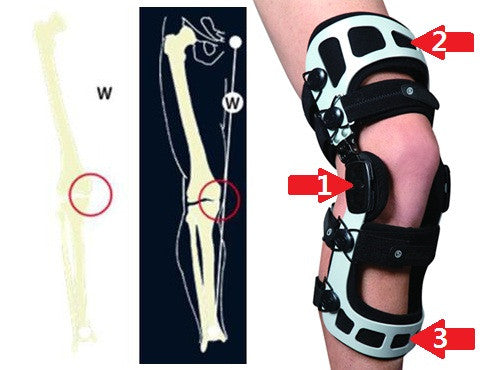
What causes OA? How does a knee brace help? - Valgus / Varus
What causes OA?
There are tissues in a healthy knee joint that form a natural cushion between the tibia (shin bone) and femur (thigh bone). With every step, these tissues absorb and distribute body weight across the surfaces of the knee joint. A patient diagnosed with OA has generally lost some of the tissue that provides this natural cushion. Instead of the bones being separated and gliding smoothly on a cushioned surface, the bones will often grind together. This causes inflammation (joint swelling) and pain, and also contributes to the continued and progressive degeneration of the knee.
Approximately 80% of patients develop medial compartment OA, which can result in an abnormal bowing of the leg. Patients with lateral compartment OA may develop abnormal valgus leg angulation that results in a knock-knee condition. Women are more likely than men to have lateral OA.

OA can routinely be diagnosed and confirmed by a series of X-rays of your knee. A weight-bearing X-ray will typically show that the joint space on one side of the knee has narrowed or is fully collapsed. Wearing an OA knee brace can help maintain normal leg alignment and reduce joint compression.
How does a knee brace help?
If you are looking for a way to reduce your knee pain and remain as physically active as possible, OA knee bracing is a treatment option you should consider.
An OA knee brace is generally prescribed as a precursor or alternative to joint replacement. The brace applies corrective force to the leg to maintain normal alignment and redistribute load away from the damaged side of the knee.
Wearing an OA knee brace can reduce your knee pain, slow down the continued degeneration of your knee joint, and potentially allow you to stay more active.
While many people with OA experience health benefits from wearing an OA knee brace, not every patient is a good candidate for a brace. You should ask your doctor if an OA knee brace is a viable treatment option for you.
The left image illustrates a knee that has lost the natural cushion between bony surfaces in the knee joint, causing abnormal leg angulation and compression on one side of the knee.
The right image shows how a Orthomen OA knee brace applies stabilizing and three point corrective forces. This helps maintain normal leg alignment and reduces joint compression.
============================================================

The OA Knee Brace Booster is a lightweight, low-profile unloading brace that is ideal for the active wearer. A sturdy frame and easy-to-use, push-button unloading mechanism help to quickly and easily align the leg and unload pressure on the knee joint. This particular knee orthosis features a simple strapping system as well as an open design, making it simple to apply and adjust, while promoting optimum ventilation, keeping the wearer cool and comfortable.
Indications
● Mild to moderate OA knee for arthritis
● Instability of knee joint or ligament injury
● Protect knee joint after knee surgery
● Ligament injury or meniscus injury
● Mild to moderate OA knee for arthritis
● Instability of knee joint or ligament injury
● Protect knee joint after knee surgery
● Ligament injury or meniscus injury
● Knock knee brace correction
Features:
● Support knee joint and share the loading force
● Provide stability for better healing of injured tissue
● Prevent injury in recovery phase after surgery
● New material of anti slipping PU foam
● Specific design for left or right side
● S, M, L, XL (Left/Right)

Valgus Adjustment for Right Leg

Varus Adjustment for Right Leg
- Choosing a selection results in a full page refresh.

15 comments
Eric
Good news
Marks
I love the brace, it is great work. I have tried many knee braces and all offered little or no relief until I discovered the Orthomen functional ACL Knee Brace. Now I can pay basketball
Tinna
Great works
Kevin
exactly what I’ve been looking for. very comfortable and the fit is perfect. delivered 10 days after ordering. very pleased
Samir escalona
Excellent